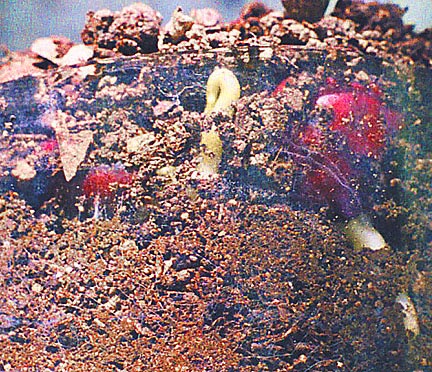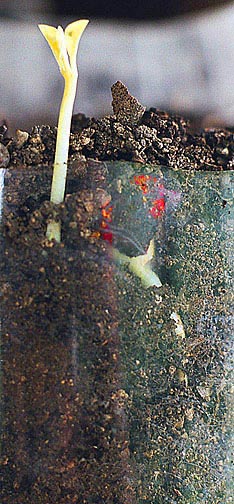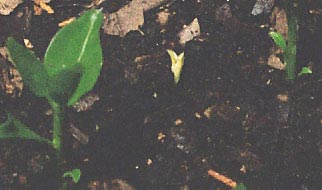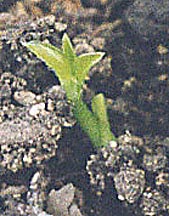


The structure of the mountain laurel seed is illustrated above. The seed views labled 'A' represent the typical mature seed. Views B and C show cross sections by cutting following the lines across the seed to their left. B was cut between the two cotyledons, one being removed to show the red coloring of the innermost portion of the inner seed coat. C was cut across the cotyledons, so half of both are visible. Both B and C show the dark red outer seed coat, then a more complex, largely light-colored, inner seed coat. The growth axis of the embryo lies roughly at the end of the yellow lines.
Views D and E also show the layering of the seed coats. In D a slice has been cut just into the layers of the inner coat - i.e., deep red outer coat, lighter layers, then the reddish innermost layer. In E a deeper slice has included a portion of a cotyledon. Scarification should not proceed deeper than the slice in D.

Germination occurs underground long before any visible indication. The above photo of two seeds germinating in a glass pot (sheltered from light) shows one seed putting down its root and the other already producing a shoot. The shots below were taken several days later. By that time the red of the shell had largely disappeared - it has been enhanced to help match the two shoots with the stage above. By the final shot sufficient light had leaked into the glass setup that the cotyledons were turning green - not a normal development.

|

|
Also clear from the above is the hypogeous nature of the germination - the cotyledons remain underground, providing nourishment for establishing a long root long before leaves are available to support growth.
The plant in the middle below is the same as the yellow shoot to its left, photographed several days earlier. The root had already reached the bottom of the 1-gallon container in which it germinated. The green portion of the plant was above ground, and the cotyledons, a full inch below the surface, still retain pinkish color from the seed coat.

|

|

|
To test the viability of early summer seeds, 8 seeds were slightly scarified (not to the inner seed coat), soaked in rainwater for several hours, and planted in a single pot. Seven germinated within two weeks; one rotted - it was a very humid, rainy period. In the photo the last to germinate, still yellow, had just broken the surface.

Obviously one should not crowd 7 or 8 mountain laurels into a single small pot. It was impossible to extract them from the pot without damaging their roots; three broke off half way down. Nonetheless all survived until moved to the ground in November. Because they are such slow growers, a month later it was impossible to discern which three had the broken roots. Other groups of several seedlings were kept all summer in gallon pots and successfully separated without apparent damage in November.